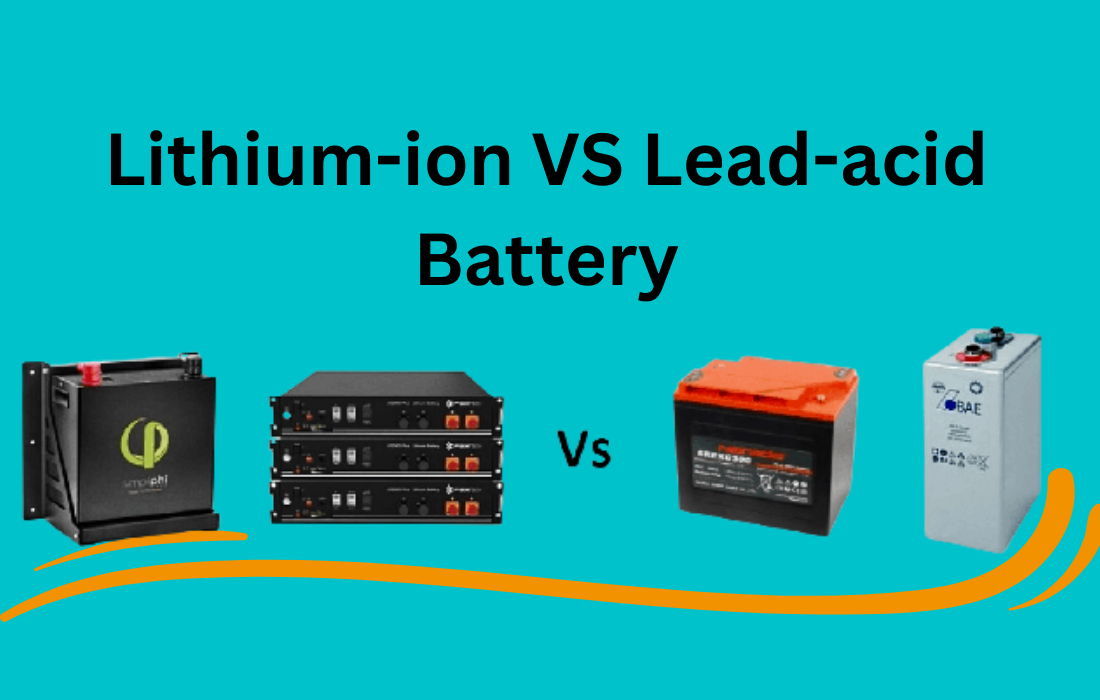Traditionally the entire solar energy market and the home energy storage market are ruled by Lead-acid batteries. But now the scenario is changing. Day by day and slowly lithium-ion batteries are making their way into this market. In this article, we will run an analysis of the difference between lithium-ion and lead-acid batteries. We will understand the difference based on cycle life, depth of discharge, efficiency, charge rate, and energy density.
Lead-acid Battery: Lead-acid is a tried-and-true technology that is less expensive but requires frequent maintenance and does not last as long as other technologies.
Lithium-ion Battery: Lithium is a premium battery technology that has a longer lifespan and higher efficiency, but it comes at a higher price.
Cycle life of lithium-ion and Lead-acid Battery
One charge cycle is when you deplete a battery (use it to power your appliances) and then charge it again using your panels. We don’t count years when we talk about battery life; instead, we count how many cycles they can take before they die.
Consider it similar to putting miles on a car. When determining the condition of a secondhand car, mileage is far more important than the year of manufacture.
The same may be said about batteries and how many times they’ve been cycled. A sealed lead-acid battery for a home may go through 300+ cycles in a year.
The one that has completed 100 cycles is in considerably better condition.
The depth of discharge affects cycle life as well (how much capacity you use before recharging a battery). Deeper discharges put the battery under additional stress, reducing its cycle life.
Depth of Discharge lithium-ion and Lead-acid Battery
The amount of overall capacity used before recharging the battery is referred to as discharge depth. If you consume a quarter of your battery’s capacity, for example, the depth of discharge is 25%.
When you use a battery, it does not entirely discharge. Instead, they have a recommended depth of discharge, which tells you how much you can use before having to replenish them.
Lead-acid batteries should only be discharged to 50% of their capacity. You risk shortening their lives if you go beyond that limit.
Lithium batteries, on the other hand, can withstand deep discharges of up to 80%. This just indicates that they have a larger useful capacity.
Lithium batteries are more efficient than other types of batteries. As a result, more of your solar energy is retained and utilised.
Lead acid utilized batteries, for example, are only 80-85% efficient depending on the brand and condition. That means that if you have 1,000 watts of solar power streaming into the batteries, after the charging and discharging process, you’ll only have 800-850 watts accessible.
Lithium batteries have a high efficiency of over 95%. You’d have over 950 watts of electricity available in the same scenario.
Your batteries will charge faster if they are more efficient. It may also mean purchasing fewer solar panels, less battery capacity, and a smaller backup generator, depending on the architecture of your system.
Charge Rate lithium-ion and Lead-acid Battery
For lithium batteries, higher efficiency means a faster rate of charging. Because they can tolerate more current from the charger, they can be replaced considerably faster than lead-acid batteries.
The charge rate is expressed as a fraction, such as C/5, where C is the battery’s capacity in amp-hours (Ah). So, if you charge a 430 Ah battery at C/5, you’ll get 86 charging amps (430/5).
The amount of charge current that lead-acid batteries can handle is limited, mostly because they will overheat if charged too quickly. Furthermore, when you near are full capacity, the charge rate slows dramatically.
During the bulk phase, lead acid batteries can charge to roughly C/5 (up to 85% capacity). After that, the battery charger slows down to fully charge the batteries. As a result, lead-acidlead-acid batteries take longer to charge, often more than twice as long as Lithium-ion batteries.
Energy Density lithium-ion and Lead-acid Battery
Both of the lead-acid batteries in the comparison weigh roughly 125 pounds. The lithium battery is 192 pounds in weight.
Most installers can tolerate the added weight, but lithium batteries may be more difficult to install for DIYers. It’s a good idea to enlist some assistance with lifting and moving them into position.
However, there is a cost: lithium batteries have a significantly better energy density than lead-acid batteries, which means they can put more storage capacity into a smaller size.
As you can see in the example, two lithium batteries are required to power a 5.13 kW system, whereas eight lead-acid batteries would be required. Lithium is less than half the weight of lead when the full battery bank is considered.
If you need to be creative with how you mount your battery bank, this can be a huge help. The enhanced energy density lets your lithium battery bank fit into tighter locations, whether you’re hanging it on the wall or storing it in a closet.
If you need to be creative with how you mount your battery bank, this can be a huge help. The enhanced energy density lets your lithium battery bank fit into tighter locations, whether you’re hanging it on the wall or storing it in a closet.
When should you install a lead-acid battery vs. a lithium-ion battery?
Lead-acid and lithium-ion batteries are both viable solutions for a battery backup system. However, considering the many benefits of lithium-ion technology, such as a longer lifetime, higher efficiency, and higher energy density, installing a lithium-ion battery is usually the best choice. Lithium-ion batteries are usually more valuable than lead-acid batteries, despite their higher initial costs.
In a scenario with an off-grid solar installation that isn’t used very often, lead-acid batteries might be the best option.
For example, maintaining a lead-acid battery on a boat or RV as a backup power source that is only used once or twice a month is a less expensive choice than lithium-ion, and you’ll avoid many of the limitations of lead-acid technology, such as their shorter lifespan, the because of the lower usage rate.
Advantages and Disadvantages of Lithium-ion and Lead-acid Batteries
Advantages of Lithium-ion Batteries
- Higher Energy Density: Lithium-ion batteries have a higher energy density compared to lead-acid batteries. This means that they can store more energy in a smaller size and weight.
- Longer Lifespan: Lithium-ion batteries have a longer lifespan compared to lead-acid batteries. They can last up to 5 years or more, depending on the usage and maintenance.
- Faster Charging: Lithium-ion batteries can be charged much faster compared to lead-acid batteries. They can be charged up to 80% in just 30 minutes.
- Low Maintenance: Lithium-ion batteries require very little maintenance compared to lead-acid batteries. They do not require periodic topping up of electrolyte or equalizing charges.
- Eco-Friendly: Lithium-ion batteries are much more eco-friendly compared to lead-acid batteries. They do not contain any toxic materials like lead or acid, which can be harmful to the environment.
Disadvantages of Lithium-ion Batteries
- High Cost: Lithium-ion batteries are more expensive compared to lead-acid batteries. This is because of the high cost of raw materials used in the manufacturing process.
- Safety Concerns: Lithium-ion batteries are prone to thermal runaway, which can cause a fire or explosion. This can happen due to overcharging, overheating, or physical damage to the battery.
- Limited Temperature Range: Lithium-ion batteries have a limited temperature range. They do not work well in extreme temperatures, both hot and cold.
Advantages of Lead-acid Batteries
- Low Cost: Lead-acid batteries are much cheaper compared to lithium-ion batteries. They are widely used in many applications because of their low cost.
- High Power Output: Lead-acid batteries can deliver high power output, making them suitable for applications like starting a car or powering heavy machinery.
- Wide Temperature Range: Lead-acid batteries can operate in a wide temperature range, making them suitable for use in extreme weather conditions.
- Proven Technology: Lead-acid batteries have been around for a long time and are a proven technology. They are reliable and have been used in many applications for decades.
Disadvantages of Lead-acid Batteries
- Heavy and Bulky: Lead-acid batteries are heavy and bulky compared to lithium-ion batteries. This makes them unsuitable for applications where weight and size are critical factors.
- Shorter Lifespan: Lead-acid batteries have a shorter lifespan compared to lithium-ion batteries. They typically last between 2-3 years and require regular maintenance.
- Maintenance: Lead-acid batteries require periodic topping up of electrolyte and equalizing charges. Failure to do so can result in reduced performance and a shorter lifespan.
- Environmental Concerns: Lead-acid batteries contain toxic materials like lead and acid, which can be harmful to the environment if not disposed of properly.
FAQ’s
Lithium batteries generally offer higher energy density, longer lifespan, and faster charging times compared to lead acid batteries. Lead acid batteries, on the other hand, are typically more affordable and better suited for high-current applications.
In recent years, lithium batteries have gained popularity in automotive applications due to their higher energy density, lighter weight, and better overall performance. However, lead acid batteries still find use in some specific automotive applications, such as traditional internal combustion engine vehicles.
Lithium batteries generally have a longer lifespan than lead acid batteries. While the lifespan of lead acid batteries is typically around 3-5 years, lithium batteries can last 8-10 years or even longer, depending on the specific battery chemistry and usage patterns.
Both lithium and lead acid batteries have safety considerations. Lithium batteries can be more prone to thermal runaway and require proper protection circuits to prevent overcharging or overheating. Lead acid batteries contain corrosive sulfuric acid and must be handled with care to avoid leaks or spills.
While the upfront cost of lithium batteries is typically higher than lead acid batteries, they can be more cost-effective in the long run due to their longer lifespan and higher efficiency. However, the cost-effectiveness may vary depending on specific applications and the price of battery technologies.
In many cases, lithium batteries can be used as a direct replacement for lead acid batteries in existing systems. However, it’s important to consider factors such as voltage compatibility, charging requirements, and potential modifications to the system’s charging or monitoring circuitry.
Lithium batteries generally perform better in extreme temperatures compared to lead acid batteries. They can operate in a wider temperature range, both in high and low temperatures, without significant performance degradation. Lead acid batteries, however, can experience reduced capacity and efficiency in extreme temperatures.
Lithium batteries have minimal maintenance requirements. They do not require regular electrolyte checks or topping up like lead acid batteries. However, it’s important to monitor their charging and discharging parameters to prevent overcharging or deep discharge. Lead acid batteries may require occasional maintenance such as checking electrolyte levels and ensuring proper ventilation.


